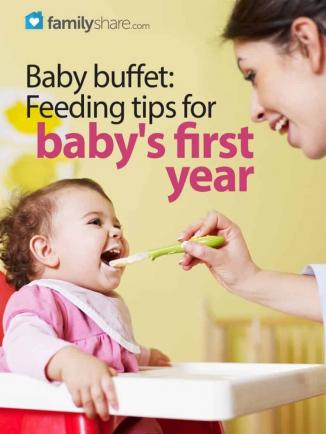
Babies love to put things in their mouths. It's up to you to make sure the food that goes in your child's mouth is age-appropriate. Medical advice about what to feed babies changes often. This article offers the most up-to-date information on feeding your little one for the first year.
Birth to 6 months
Feeding baby for the first six months is very straightforward. From birth to 6 months, babies should only eat breast milk or formula. No rice cereal, no pureed vegetables and certainly no bites of dad's ice cream. The American Academy of Pediatrics recently raised the age to start solid foods from 4 months to 6 months, in part due to studies that herald the benefits of breastfeeding for at least six months. If you have questions about these new guidelines, discuss them with your pediatrician.
Six to 9 months
Now is the exciting time you've been waiting for. Your baby is most likely interested in your food and family meal times. He is sitting up and can put his hands to his mouth. Although you can start your baby with fruits or vegetables, you may want to choose a simple grain like rice cereal or baby oatmeal. Mixed with breast milk or formula, the mild taste is easy for baby to tolerate.
Some people suggest feeding baby vegetables before fruits so she won't develop a preference for sweet foods. Fruits and vegetables commonly introduced in the early stages of solid feeding are sweet potatoes, carrots, peas, green beans, squash, pears, applesauce and bananas. My babies loved the mild taste and smooth texture of avocado. You can also mix the vegetable purees with a bit of rice cereal to tone down the flavor and thicken up the cereal. Be sure to give your baby a very small amount on the spoon at a time. As you first begin solid feeding, your baby might not eat very much. That is normal. Most of his or her nutritional needs will still be met from breast milk or formula.
At this age you can also introduce pureed legumes (like black beans and lentils) and pureed meats or tofu. Introduce foods one at a time and wait two to three days before introducing a new food. Watch for signs of allergy or intolerance, like rash, diarrhea or vomiting.
Nine to 12 months
Now that your baby is able to grasp food and swallow easily, there are a lot more options. If your little one has teeth, or the ability to chew and swallow well, you can start finger foods like small bits of toasted bagel, dry cereal, small pieces of pasta, banana chunks and teething crackers.
In addition to fun finger foods, you can introduce dairy products like yogurt (look for low-sugar, full-fat varieties), soft cheese and cottage cheese. Hard-boiled or scrambled eggs are also a good protein option for older babies. Meats must be thoroughly shredded or pureed with other foods to prevent a choking hazard. Beans, fruits and vegetables can now be mashed instead of pureed.
Foods to avoid
Babies should not eat honey for the first year of life due to risk of infant botulism, a form bacteria that causes severe illness. You will also need to avoid foods that pose a choking hazard, like grapes and small tomatoes or hard foods like carrots. Nut butters can be too sticky for babies to swallow; some candies pose the same problem. Avoid giving cow's milk until age one, as the proteins are hard for babies to digest.
If your family has a history of food allergies, discuss with your doctor how to proceed. For example, some doctors suggest avoiding peanuts for up to two years in families where a peanut allergy is present.
Your baby may be ready for foods slightly earlier than suggested here. On the other hand, your 8 month-old might not be ready for finger foods until 10 months. Be sure to discuss your child's development with your pediatrician at your baby's well-child visits, and bon appétit!

